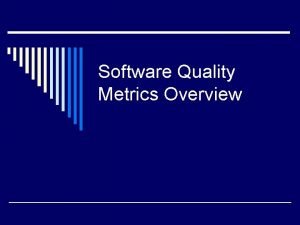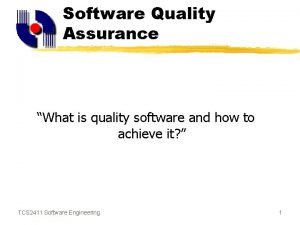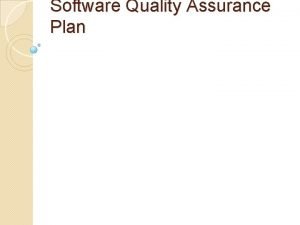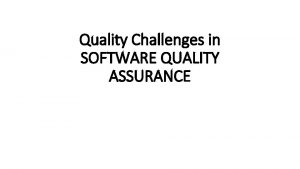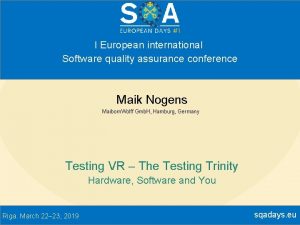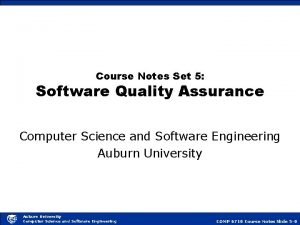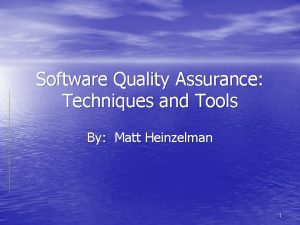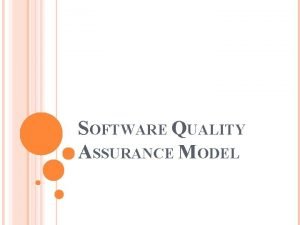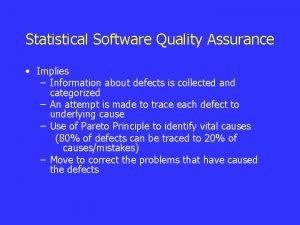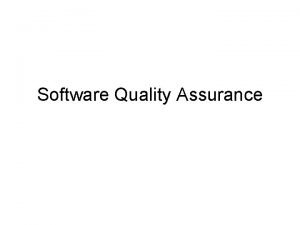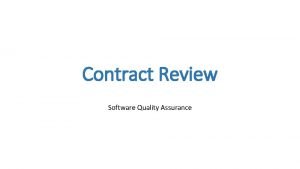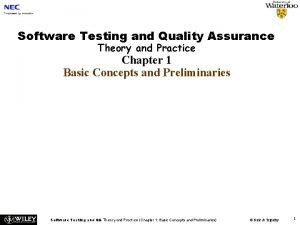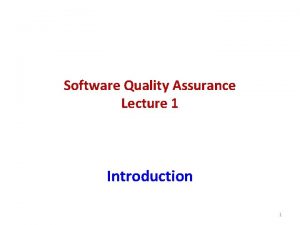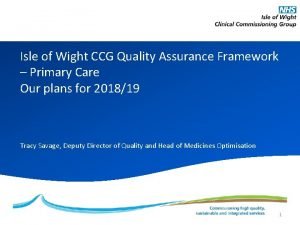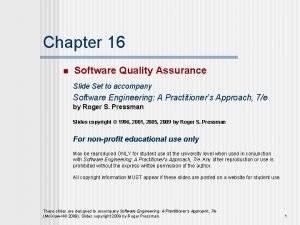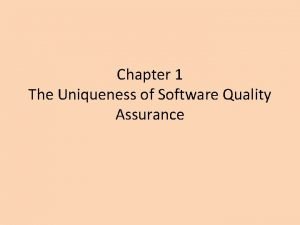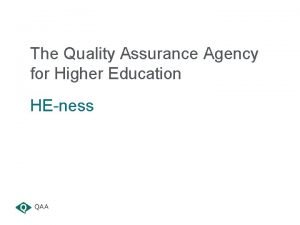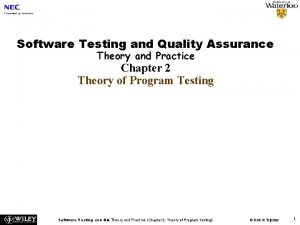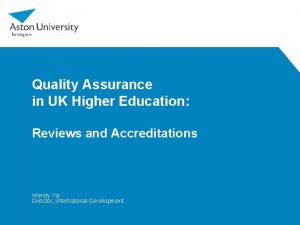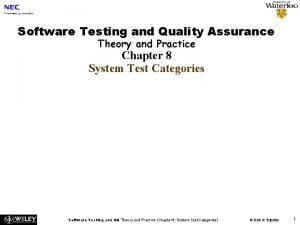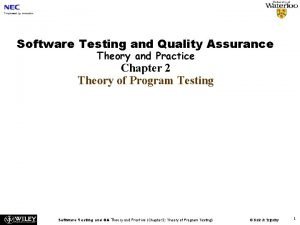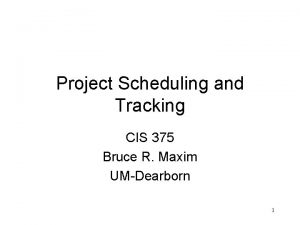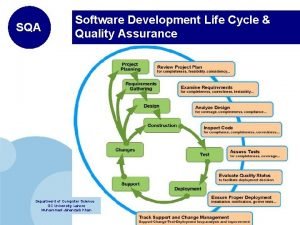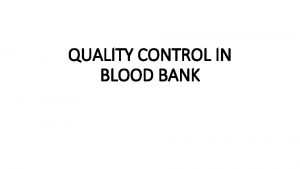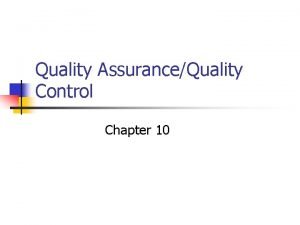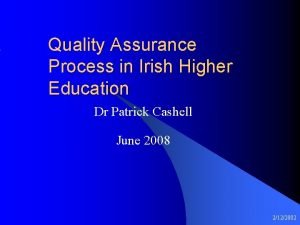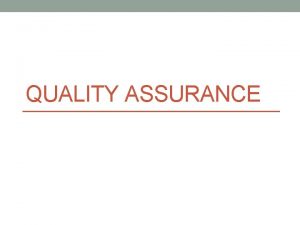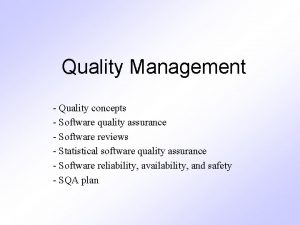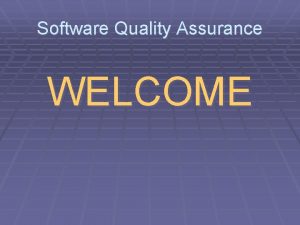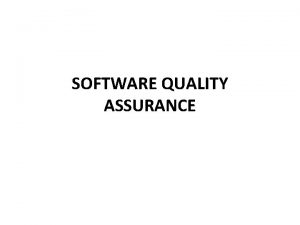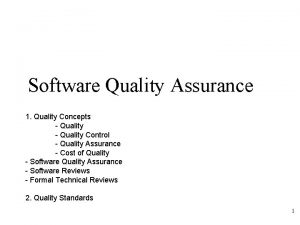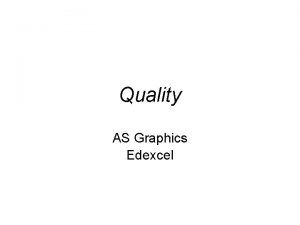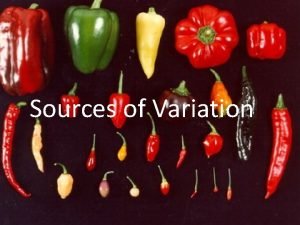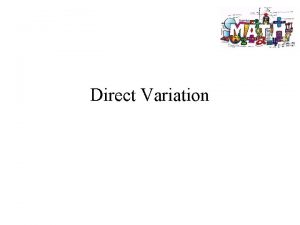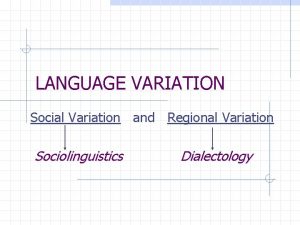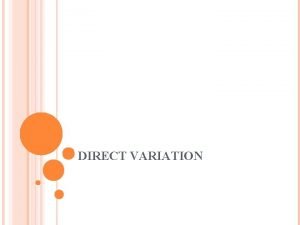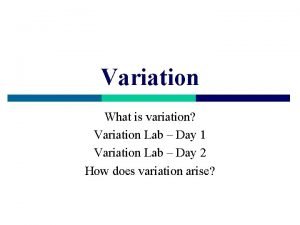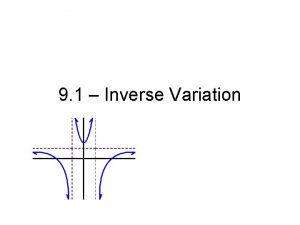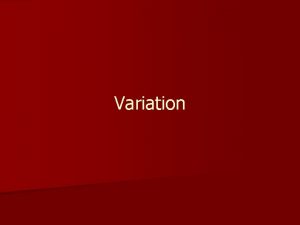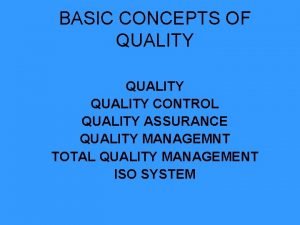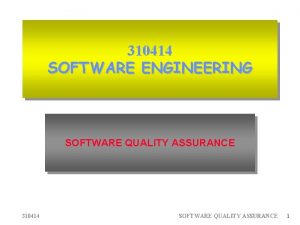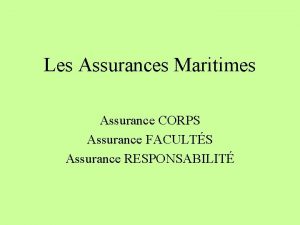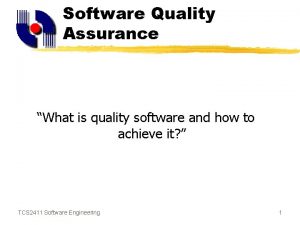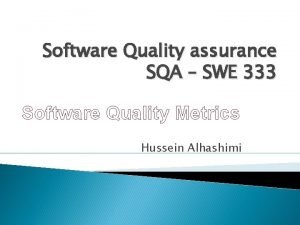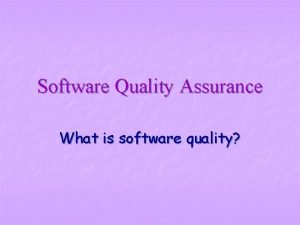Software Quality Assurance 1 Quality Concepts 1 Variation




































- Slides: 36

Software Quality Assurance 1

Quality Concepts - 1 • Variation control is the heart of quality control • Software engineers strive to control the – process applied – resources expended – end product quality attributes • Quality of design – refers to characteristics designers specify for the end product to be constructed 2

Quality Concepts - 2 • Quality of conformance – degree to which design specifications are followed in manufacturing the product • Quality control – series of inspections, reviews, and tests used to ensure conformance of a work product to its specifications • Quality assurance – auditing and reporting procedures used to provide management with data needed to make proactive decisions 3

Quality Costs • Prevention costs – quality planning, formal technical reviews, test equipment, training • Appraisal costs – in-process and inter-process inspection, equipment calibration and maintenance, testing • Failure costs – rework, repair, failure mode analysis • External failure costs – complaint resolution, product return and replacement, help line support, warranty work 4

Total Quality Management - 1 • Kaizen – develop a process that is visible, repeatable, and measurable • Atarimae hinshitsu – examine the intangibles that affect the process and work to optimize their impact on the process 5

Total Quality Management - 2 • Kanse – examine the way the product is used by the customer with an eye to improving both the product and the development process • Miryokuteki hinshitsu – observe product use in the market place to uncover new product applications and identify new products to develop 6

Software Quality Assurance • Conformance to software requirements is the foundation from which software quality is measured. • Specified standards are used to define the development criteria that are used to guide the manner in which software is engineered. • Software must conform to implicit requirements (ease of use, maintainability, reliability, etc. ) as well as its explicit requirements. 7

SQA Group Activities - 1 • Prepare SQA plan for the project. • Participate in the development of the project's software process description. • Review software engineering activities to verify compliance with the defined software process. 8

SQA Group Activities - 2 • Audit designated software work products to verify compliance with those defined as part of the software process. • Ensure that any deviations in software or work products are documented and handled according to a documented procedure. • Record any evidence of noncompliance and reports them to management. 9

Software Reviews • Purpose is to find defects (errors) before they are passed on to another software engineering activity or released to the customer. • Software engineers (and others) conduct formal technical reviews (FTR) for software engineers. • Using formal technical reviews (walkthroughs or inspections) is an effective means for improving software quality. 10

Review Roles • Presenter (designer/producer). • Coordinator (not person who hires/fires). • Recorder – records events of meeting – builds paper trail • Reviewers – – maintenance oracle standards bearer user representative others 11

Formal Technical Reviews - 1 • Involves 3 to 5 people (including reviewers) • Advance preparation (no more than 2 hours person) required • Duration of review meeting should be less than 2 hours • Focus of review is on a discrete work product • Review leader organizes the review meeting at the producer's request. 12

Formal Technical Reviews - 2 • Reviewers ask questions that enable the producer to discover his or her own error (the product is under review not the producer) • Producer of the work product walks the reviewers through the product • Recorder writes down any significant issues raised during the review • Reviewers decide to accept or reject the work product and whether to require additional reviews of product or not. 13

Why do peer reviews? • To improve quality. • Catches 80% of all errors if done properly. • Catches both coding errors and design errors. • Enforce the spirit of any organization standards. • Training and insurance. 14

Formality and Timing • Formal review presentations – resemble conference presentations. • Informal presentations – less detailed, but equally correct. • Early – tend to be informal – may not have enough information • Later – tend to be more formal – Feedback may come too late to avoid rework 15

Formality and Timing • • • Analysis is complete. Design is complete. After first compilation. After first test run. After all test runs. Any time you complete an activity that produce a complete work product. 16

Review Guidelines • • Keep it short (< 30 minutes). Don’t schedule two in a row. Don’t review product fragments. Use standards to avoid style disagreements. • Let the coordinator run the meeting and maintain order. 17

Formal SQA Approaches 1. Proof of correctness. 2. Statistical quality assurance. 3. Cleanroom process combines items 1 & 2. 18

Statistical Quality Assurance • Information about software defects is collected and categorized • Each defect is traced back to its cause • Using the Pareto principle (80% of the defects can be traced to 20% of the causes) isolate the "vital few" defect causes • Move to correct the problems that caused the defects 19

Software Reliability • Defined as the probability of failure free operation of a computer program in a specified environment for a specified time period • Can be measured directly and estimated using historical and developmental data (unlike many other software quality factors) • Software reliability problems can usually be traced back to errors in design or implementation. 20

Software Reliability Metrics • Reliability metrics are units of measure for system reliability • System reliability is measured by counting the number of operational failures and relating these to demands made on the system at the time of failure • A long-term measurement program is required to assess the reliability of critical systems 21

Reliability Metrics - part 1 • Probability of Failure on Demand (POFOD) – POFOD = 0. 001 – For one in every 1000 requests the service fails per time unit • Rate of Fault Occurrence (ROCOF) – ROCOF = 0. 02 – Two failures for each 100 operational time units of operation 22

Reliability Metrics - part 2 • Mean Time to Failure (MTTF) – average time between observed failures (aka MTBF) • Availability = MTBF / (MTBF+MTTR) – MTBF = Mean Time Between Failure – MTTR = Mean Time to Repair • Reliability = MTBF / (1+MTBF) 23

Time Units • Raw Execution Time – non-stop system • Calendar Time – If the system has regular usage patterns • Number of Transactions – demand type transaction systems 24

Software Safety • SQA activity that focuses on identifying potential hazards that may cause a software system to fail. • Early identification of software hazards allows developers to specify design features to can eliminate or at least control the impact of potential hazards. • Software reliability involves determining the likelihood that a failure will occur without regard to consequences of failures. 25

Validation Perspectives • Reliability validation – Does measured system reliability meet its specification? – Is system reliability good enough to satisfy users? • Safety validation – Does system operate so that accidents do not occur? – Are accident consequences minimized? • Security validation – Is system secure against external attack? 26

Validation Techniques • Static techniques – design reviews and program inspections – mathematical arguments and proof • Dynamic techniques – statistical testing – scenario-based testing – run-time checking • Process validation – SE processes should minimize the chances of introducing system defects 27

Static Validation Techniques • Concerned with analysis of documentation • Focus is on finding system errors and identifying potential problems that may arise during system operation • Documents may be prepared to support static validation – structured arguments – mathematical proofs 28

Static Safety Validation Techniques • Demonstrating safety by testing is difficult • Testing all possible operational situations is impossible • Normal reviews for correctness may be supplemented by specific techniques intended to make sure unsafe situations never arise 29

Safety Reviews • Intended system functions correct? • Is structure maintainable and understandable? • Verify algorithm and data structure design against specification • Check code consistency with algorithm and data structure design • Review adequacy of system testing 30

Hazard-Driven Analysis • Effective safety assurance relies on hazard identification • Safety can be assured by – hazard avoidance – accident avoidance – protection systems • Safety reviews should demonstrate that one or more of these techniques have been applied to all identified hazards 31

System Safety Case • The normal practice for a formal safety case to be required for all safety-critical computerbased systems • A safety case presents a list of arguments, based on identified hazards, as to why there is an acceptably low probability that these hazards will not result in an accident • Arguments can be based on formal proof, design rationale, safety proofs, and process factors 32

Poka-Yoke Devices • Mechanisms that lead to the prevention of a potential quality problem before it occurs or to the rapid detection of a quality problem if one is introduced • Are a simple, cheap, part of the engineering process, and are located near the process task where the mistakes are likely to occur 33

SQA Plan – 1 • Management section – describes the place of SQA in the structure of the organization • Documentation section – describes each work product produced as part of the software process • Standards, practices, and conventions section – lists all applicable standards/practices applied during the software process and any metrics to be collected as part of the software engineering work 34

SQA Plan - 2 • Reviews and audits section – provides an overview of the approach used in the reviews and audits to be conducted during the project • Test section – references the test plan and procedure document and defines test record keeping requirements 35

SQA Plan - 3 • Problem reporting and corrective action section – defines procedures for reporting, tracking, and resolving errors or defects, identifies organizational responsibilities for these activities • Other – tools, SQA methods, change control, record keeping, training, and risk management 36
 Basic concepts of quality control
Basic concepts of quality control Quality control and quality assurance
Quality control and quality assurance Quality control vs quality assurance pmp
Quality control vs quality assurance pmp Pmbok quality management
Pmbok quality management Quality assurance model in nursing
Quality assurance model in nursing Compliance vs quality
Compliance vs quality Types of metrics software
Types of metrics software Iso 9001 software quality assurance
Iso 9001 software quality assurance Quality assurance plan in software engineering
Quality assurance plan in software engineering Software quality challenges
Software quality challenges Maiborn wolff
Maiborn wolff Software quality assurance notes
Software quality assurance notes Software testing and quality assurance: theory and practice
Software testing and quality assurance: theory and practice Software quality assurance tools and techniques
Software quality assurance tools and techniques Software quality assurance models
Software quality assurance models Statistical quality assurance in software engineering
Statistical quality assurance in software engineering Statistical software quality assurance
Statistical software quality assurance Software quality assurance is an umbrella activity
Software quality assurance is an umbrella activity #1 contract review software
#1 contract review software Software testing and quality assurance: theory and practice
Software testing and quality assurance: theory and practice Introduction to software quality assurance
Introduction to software quality assurance The isle quality assurance
The isle quality assurance Software quality assurance slideshare
Software quality assurance slideshare Uniqueness of software quality assurance
Uniqueness of software quality assurance Software quality assurance agency
Software quality assurance agency Theory of goodenough and gerhart
Theory of goodenough and gerhart Software quality assurance agency uk
Software quality assurance agency uk Software testing and quality assurance theory and practice
Software testing and quality assurance theory and practice Quality assurance theory
Quality assurance theory Project scheduling and tracking software quality assurance
Project scheduling and tracking software quality assurance Direct variation
Direct variation Direct variation vs inverse variation
Direct variation vs inverse variation Correlation and regression
Correlation and regression Sqa life cycle
Sqa life cycle Whole blood quality control
Whole blood quality control Quality control purpose
Quality control purpose Iuqb
Iuqb






